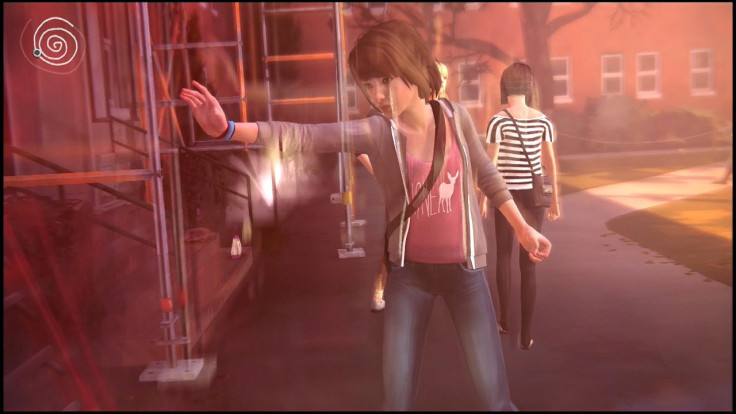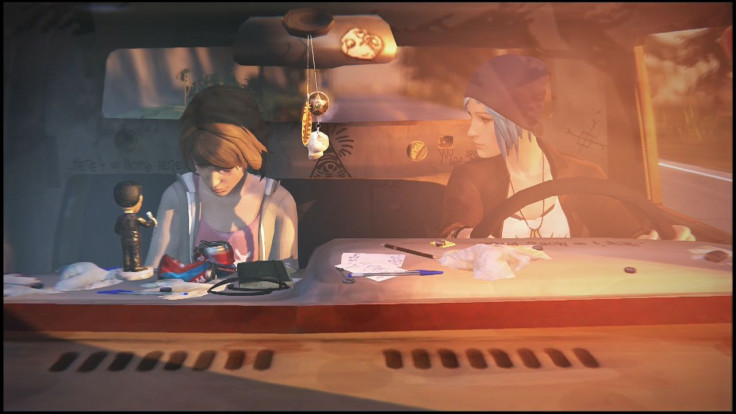'Life Is Strange' Episode One Review: Square Enix Gambles With Female Protagonists

“Life Is Strange” is an episodic, coming of age story from Dontnod Studios, a small French team who have a penchant for female protagonists. The game follows the life of Maxine Caulfield (a name likely referencing the brooding young Holden Caulfield of “Catcher In The Rye”), a late-teen photographer who’s returned to her home town of Arcadia, Oregon after five years in Seattle to attend a prestigious academy. She reunites with her childhood friend Chloe (who’s become a rebel in the past half-decade) and, through a series of mystical and to this point inexplicable events, gains to ability to manipulate time. It's a risky venture, given how many publishers wanted to change the leads to males.
The first episode, “Chrysalis,” (a word that usually refers to the pupa stage of an insect, just before adulthood) is the beginning of Max’s coming of age; an appropriate metaphor.
Max’s overt awkwardness, offset by a supernatural ability everyone has secretly wished for (to change our mistakes) turns her into the teenagers we remember ourselves being: physically primed for adulthood, but mentally and emotionally unready. Combined with the somber yet sweet story and masterful music, the first episode of Life Is Strange can resonate with anyone -- even if that person is the opposite sex. It pushes the idea that the normal, everyday machinations of life can still be interesting.

Max can rewind time to recreate moments or change the way she talks to the people around her -- it’s essentially a “do-over’ button in a game all about living with the consequences of your actions. While its origin remains a mystery for now, I’m not entirely sold on the idea yet; sure, being able to see both (in some cases all) of the immediate reactions your choices have without playing the game a second time certainly saves time, it cheapens the gravity of each decision. Sure, you can ultimately only pick one option and the rest of the storyline will be affected by it, but Max can rewind any situation infinitely and deliberate as many times as necessary. Maybe this speaks to the nature of her power (she can only turn back time a short amount, not fix mistakes years in the making), but it feels a bit like cheating.
Then again, having the ability to manipulate time in real life would be cheating by any definition. Dontnod’s angle is novel and helps make Max’s normal life more enthralling, but it’s difficult to say what impact it’ll truly have until the entire story has played out.
As with other story-driven games (most notably the numerous series from Telltale Games), Life Is Strange’s appeal lies in the details. Max can interact with much of the objects in the world around her, and each object or person produces a short monologue or affects part of the story. Each thing found provides a bit more insight into the mind of Max, a flashback for every adult who was that shy teenager.

But even those observations serve to enhance the main tool of the game: dialogue. Life Is Strange’s story is driven by interactions between the characters, but Max and Chloe take the majority of the limelight. Worryingly. conversations between them feel a bit stilted and their slang seems outmoded. The first makes sense, at least -- they were best friends who haven’t spoken in five years (Max’s fault) and Chloe is rightfully bitter about it. The second may just be me getting old, or a regional vernacular difference, but Chloe’s overuse of “hella” never failed to produce an eyeroll. Then again, when I was that age, I was referring to things as “mad cool,” so it could just be Chloe’s personality. No one else is in on her slang, for now.
The story purposefully revolves around these two, but the supporting characters are intriguing as well. It’s refreshing to see a game with such a diverse character roster made up of all different sizes, shapes, and colors; there are definitely some high school archetypes so far (see the bratty rich girl, bullied fat kid, etc.) but this isn’t a bad thing. If anything, the presence of cliques and stereotypes in a school setting lend the story’s setting some credence. Even the most stereotypical characters on the surface seem to have at least a bit more depth to them, though a single 2-3 hour episode isn’t enough time to test that hypothesis.

However, that’s more than enough time to appreciate the more subtle touches of Life Is Strange. Everything Max can interact with, from dialogue menus to jewelry collections and her own scrapbook is brushed with a hand-scratched colored pencil aesthetic that contrasts with the rest of the game’s mixture of classic Square Enix CGI and oil/water painting styles. Backing the art up is a wonderfully light and fitting indie rock soundtrack -- the kind of music Max looks like she’d listen to. Combined with the movie-like cinematography, it can help you lose yourself in peaceful moments, remembering when you were that person.
More than anything, episodic story games should pride themselves on the feelings they evoke and experiences they grant. Life Is Strange shows promise, even it relies on the same “consequence of choice” mechanic other games have popularized before it. Max is certainly different from the traditional leads in video games, and I’m glad a AAA publisher like Square Enix decided to back the project. But Life Is Strange is only Dontnod’s second game, and they’re not a known brand like Telltale that gamers will necessarily go back to when each episode is released.

It’s a bold strategy. Let’s see if it pays off.
© Copyright IBTimes 2024. All rights reserved.






















